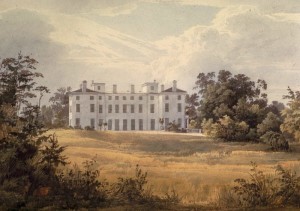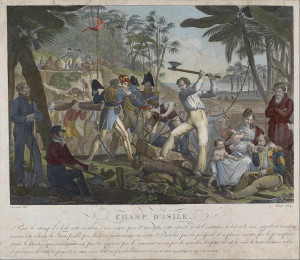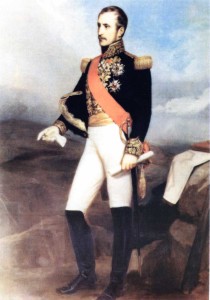 Relevant History welcomes Anna Belfrage who, had she been allowed to choose, would have become a time traveler. Instead, she became a financial professional with two absorbing interests: history and writing. Anna has authored the acclaimed time-slip series “The Graham Saga,” winner of multiple awards, including the HNS Indie Award 2015. Her new series, “The King’s Greatest Enemy,” is set in the 1320s and features Adam de Guirande, his wife Kit, and their adventures during Roger Mortimer’s rise to power. The first book, In the Shadow of the Storm, was published 1 November 2015. To learn more, visit her web site and blog, and follow Anna on Facebook and Twitter.
Relevant History welcomes Anna Belfrage who, had she been allowed to choose, would have become a time traveler. Instead, she became a financial professional with two absorbing interests: history and writing. Anna has authored the acclaimed time-slip series “The Graham Saga,” winner of multiple awards, including the HNS Indie Award 2015. Her new series, “The King’s Greatest Enemy,” is set in the 1320s and features Adam de Guirande, his wife Kit, and their adventures during Roger Mortimer’s rise to power. The first book, In the Shadow of the Storm, was published 1 November 2015. To learn more, visit her web site and blog, and follow Anna on Facebook and Twitter.
*****
On the first of August 1323, a certain Roger Mortimer managed quite the escape from the Tower of London. He’d been kicking his heels behind locked doors since January of 1322—more than eighteen months in a confined space and with a death threat hanging over him. So how come Mortimer ended up in the Tower to begin with? Well, for that we must step a couple of years backwards in time.
Background
The Mortimers were a power to be reckoned with on the Welsh Marches. As a Marcher lord, Roger would have spoken Welsh, and his household would have included a number of Welsh retainers, but he would never have defined himself as part Welsh. No, Roger Mortimer was first and foremost an English baron—and it was as a loyal servant to the crown Roger Mortimer set out to make his mark.
Initially, he was quite successful. A capable man, ruthless when so necessary, Mortimer was entrusted with various complicated missions, including the pacification of Ireland. This he did so well even the Irish were sad to see him go, and once back in England he was chosen by Edward II as one of the men charged with brokering some sort of peace between the king and his troublesome (and very powerful) cousin, Thomas of Lancaster.
However, there was a big fly in the ointment: Edward II may have been an admirable man, but he was a weak ruler with a tendency towards favouritism. In his early years as a king, it was the handsome Gascon Piers Gaveston who captured the king’s heart and ear, a relationship that ended more than badly when Edward’s barons rose in rebellion and demanded that Gaveston be exiled. When the king brought Piers back, he was summarily killed by the barons.
One would have thought that seeing one favourite killed would have made Edward careful. Maybe it did, at least for some time, but in 1315–16 a new man wormed his way into the royal affections. To be correct, two men, seeing as Hugh Despenser father and son quickly became the king’s preferred and most trusted companions. Especially the son. Soon, Edward II was seemingly incapable of making any decisions without Hugh the younger.
This was bad news for Mortimer. Despenser hated Mortimer—it had been a Mortimer who’d chopped off the head of Despenser’s grandfather, albeit on a battlefield. In actual fact, the Despensers were bad news full stop. Avaricious and ambitious, they asked the king for ever more land, more power, and Edward II was more than happy to comply, even when what he was giving them belonged to someone else…
Predictably, the barons were less than happy. Thomas of Lancaster made warning noises. Mortimer followed suit, and in 1321 the barons once again rose against the king, forcing him to exile the Despensers. An unhappy and humiliated king licked his wounds and struck back with uncharacteristic ferocity. Faced with the king’s rage, the barons sneaked off, until at last it was only Mortimer—and the powerful Earl of Lancaster.
Lancaster was not about to leave his northern power base to come to Mortimer’s aid. Severely outnumbered, Mortimer had no option but to submit, which he did in January 1322. He was thrown into the Tower, his death considered imminent…
Escape
Fortunately for Mortimer, he had friends. After all, he wasn’t the only one sick to death of Despenser and their fickle king, and so Mortimer began to plan for an escape. It helped that the king chose to reprieve him, converting the death sentence to life imprisonment. Not that Mortimer held any higher hopes of surviving all that long—what was to stop someone from entering at night and killing him?
The longer Mortimer remained in royal custody, the higher the probability that Despenser would convince the king to change his mind and execute Mortimer. At the same time, Mortimer needed time to plan things in detail—he would only get one chance.
The day the 1st of August was chosen because it was the day of St Peter ad Vincula. Tradition had it that this was a day of partying for the Tower guards, and Mortimer managed to ensure the wine was drugged. Very drugged. Once the guards were fast asleep, the sub-lieutenant d’Alspaye released Mortimer from his room. With the help of the cook, they managed to sneak into the kitchen, clamber up the chimney and escape over the roofs. Long before anyone had noticed Mortimer had fled, he was galloping hell for leather towards an obscure port on the English south coast. From there, he went to France, there to plot his revenge.
Upon hearing of Mortimer’s escape, King Edward went frantic—as did Despenser. They turned England inside out in their determined pursuit of Mortimer’s allies. Men died and were imprisoned, as were wives and children. Ultimately, none of it would help. Mortimer was a beacon for all those who no longer trusted their king—or his favourite. And soon enough, Mortimer would be joined by none other than Queen Isabella, as determined as Mortimer to rid England of the plague of the Despensers, no matter what the cost might be to her husband.
In 1326, Mortimer and Isabella returned to England at the head of an invading army. Some months later, Despenser was dead and Edward was forced to abdicate in favour of his son. The Wheel of Fortune had turned, and Mortimer had come into his own—for now.
*****
 A big thanks to Anna Belfrage. She’ll give away an autographed paperback copy of In the Shadow of the Storm to someone who contributes a comment on my blog this week. I’ll choose the winner from among those who comment by Friday at 6 p.m. ET. The giveaway is available worldwide.
A big thanks to Anna Belfrage. She’ll give away an autographed paperback copy of In the Shadow of the Storm to someone who contributes a comment on my blog this week. I’ll choose the winner from among those who comment by Friday at 6 p.m. ET. The giveaway is available worldwide.
**********
Did you like what you read? Learn about downloads, discounts, and special offers from Relevant History authors and Suzanne Adair. Subscribe to Suzanne’s free newsletter.

 Relevant History welcomes Kathy Lynn Emerson, aka Kaitlyn Dunnett, author of over fifty books. She won the Agatha Award in 2008 for best mystery nonfiction for How to Write Killer Historical Mysteries and was an Agatha Award finalist in 2014 in the best mystery short story category for “The Blessing Witch.” Currently she writes the contemporary Liss MacCrimmon Mysteries (The Scottie Barked at Midnight) as Kaitlyn and the historical Mistress Jaffrey Mysteries as Kathy (Murder in the Merchant’s Hall). The latter series is a spin-off from her earlier “Face Down” series and is set in Elizabethan England. To learn more about her and her books, visit her
Relevant History welcomes Kathy Lynn Emerson, aka Kaitlyn Dunnett, author of over fifty books. She won the Agatha Award in 2008 for best mystery nonfiction for How to Write Killer Historical Mysteries and was an Agatha Award finalist in 2014 in the best mystery short story category for “The Blessing Witch.” Currently she writes the contemporary Liss MacCrimmon Mysteries (The Scottie Barked at Midnight) as Kaitlyn and the historical Mistress Jaffrey Mysteries as Kathy (Murder in the Merchant’s Hall). The latter series is a spin-off from her earlier “Face Down” series and is set in Elizabethan England. To learn more about her and her books, visit her 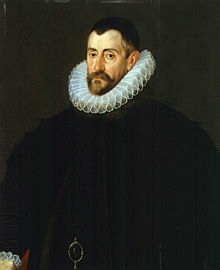 Sir Francis Walsingham, Queen Elizabeth’s principal secretary and spymaster and a secondary character in Murder in the Merchant’s Hall and the first book in the series, Murder in the Queen’s Wardrobe, appears in fictionalized form in a great many novels, so the challenge for me is to make my portrayal of him accurate but also distinct from what others have done. Here’s the tidbit I found to extrapolate from in Murder in the Merchant’s Hall: in August 1583, the queen sent Walsingham to Scotland on a diplomatic mission, and while he was there he fell ill. His poor health continued after his return to England in mid-October. It struck me that this might affect his ability to supervise his vast spy network and therefore offer one of his underlings an opportunity to advance his own agenda. From there it wasn’t much of a leap to imagine that this man’s plans could go awry and cause all kinds of difficulties for my fictional amateur detective, Rosamond Jaffrey.
Sir Francis Walsingham, Queen Elizabeth’s principal secretary and spymaster and a secondary character in Murder in the Merchant’s Hall and the first book in the series, Murder in the Queen’s Wardrobe, appears in fictionalized form in a great many novels, so the challenge for me is to make my portrayal of him accurate but also distinct from what others have done. Here’s the tidbit I found to extrapolate from in Murder in the Merchant’s Hall: in August 1583, the queen sent Walsingham to Scotland on a diplomatic mission, and while he was there he fell ill. His poor health continued after his return to England in mid-October. It struck me that this might affect his ability to supervise his vast spy network and therefore offer one of his underlings an opportunity to advance his own agenda. From there it wasn’t much of a leap to imagine that this man’s plans could go awry and cause all kinds of difficulties for my fictional amateur detective, Rosamond Jaffrey.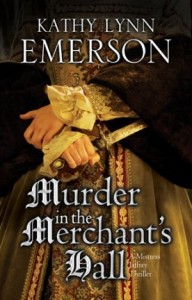 A big thanks to Kathy Emerson. She’ll give away an autographed hardback copy of Murder in the Merchant’s Hall to someone who contributes a comment on my blog this week. I’ll choose the winner from among those who comment by Friday at 6 p.m. ET. Delivery is available is the U.S. only.
A big thanks to Kathy Emerson. She’ll give away an autographed hardback copy of Murder in the Merchant’s Hall to someone who contributes a comment on my blog this week. I’ll choose the winner from among those who comment by Friday at 6 p.m. ET. Delivery is available is the U.S. only.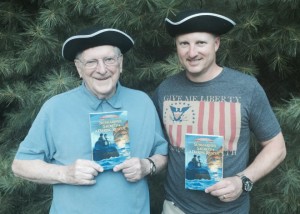 Relevant History welcomes back the father-son team Robert J. Skead, with Robert A. Skead, authors of YA historical fiction. Their ancestor Lamberton Clark fought in the Revolutionary War as a member of the Connecticut Militia and the Continental Army, and their popular children’s books include the American Revolutionary War Adventure series: Patriots, Recoats & Spies and Submarines, Secrets, and a Daring Rescue (Zondervan). To learn more about their books, visit their
Relevant History welcomes back the father-son team Robert J. Skead, with Robert A. Skead, authors of YA historical fiction. Their ancestor Lamberton Clark fought in the Revolutionary War as a member of the Connecticut Militia and the Continental Army, and their popular children’s books include the American Revolutionary War Adventure series: Patriots, Recoats & Spies and Submarines, Secrets, and a Daring Rescue (Zondervan). To learn more about their books, visit their 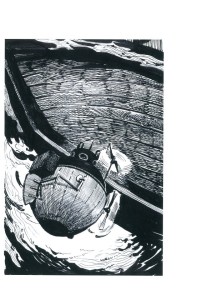 My PowerPoint presentation used for my author visits shows an image of the Turtle. One child said it looked like a giant acorn, which is true, but the American Acorn doesn’t sound so cool. Others described it as two giant clam shells stuck together, but the American Clam doesn’t work either. When the sub is in the water it looks like a turtle, hence the American Turtle, maybe not a very threatening name, except when you think of its inventor, David Bushnell, saying that his Turtle snaps on command.
My PowerPoint presentation used for my author visits shows an image of the Turtle. One child said it looked like a giant acorn, which is true, but the American Acorn doesn’t sound so cool. Others described it as two giant clam shells stuck together, but the American Clam doesn’t work either. When the sub is in the water it looks like a turtle, hence the American Turtle, maybe not a very threatening name, except when you think of its inventor, David Bushnell, saying that his Turtle snaps on command.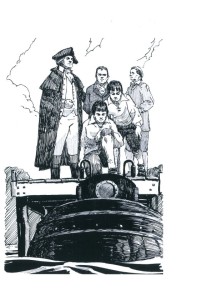 In Submarines, Secrets and a Daring Rescue, fifteen-year-old twins, Ambrose and John Clark, once again find themselves in the thick of things in service of the newly forming United States of America. Their new mission: help transport much-needed gunpowder to the patriots. When they end up in an even more dangerous situation—manning one of the first submarines—it seems the worst is behind them. Until they have to attempt a prison break to rescue one of their older brothers. Follow these brave young patriots as they continue to follow in their father’s footsteps and take even bigger leaps of faith.
In Submarines, Secrets and a Daring Rescue, fifteen-year-old twins, Ambrose and John Clark, once again find themselves in the thick of things in service of the newly forming United States of America. Their new mission: help transport much-needed gunpowder to the patriots. When they end up in an even more dangerous situation—manning one of the first submarines—it seems the worst is behind them. Until they have to attempt a prison break to rescue one of their older brothers. Follow these brave young patriots as they continue to follow in their father’s footsteps and take even bigger leaps of faith.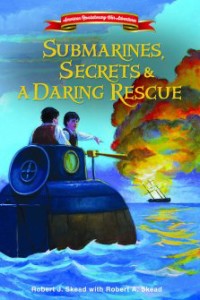 A big thanks to Robert Skead. He’ll give away autographed paperback copies of Submarines, Secrets, and a Daring Rescue to two people who contribute a comment on my blog this week. I’ll choose the winner from among those who comment by Friday at 6 p.m. ET. Delivery is available is the U.S. only.
A big thanks to Robert Skead. He’ll give away autographed paperback copies of Submarines, Secrets, and a Daring Rescue to two people who contribute a comment on my blog this week. I’ll choose the winner from among those who comment by Friday at 6 p.m. ET. Delivery is available is the U.S. only.


